The global challenge to raise the ratio of women working in the IT sector is now recognised industry-wide, and initiatives to tackle the problem are on the increase. Around the globe, companies and education institutions are revising their programme structures and workplace culture to attract and retain more female staff.
In New Zealand the gender gap across is particularly noticeable in science, technology, engineering, manufacturing (STEM) industries.
Recently, we published our regular remuneration report on the IT sector and while the numbers have been going up over the years, women still make up only 20% of the IT sector’s workforce. Understanding the issues women face within the sector will help us figure out how to inspire women to get involved in IT.
Diversity and Profitability
Research shows that companies that are more diverse are likely to be more profitable.

Where is our IT talent coming from?
From secondary education to tertiary, occupation and career progression – the stats look askew. Whilst female students beat male students when it comes to overall enrolment numbers, it takes just a quick glance at the enrolment by subject to see there’s an aversion to IT and engineering. In 2011 only 20% of students completing a Bachelor of Science in Information Technology were women.
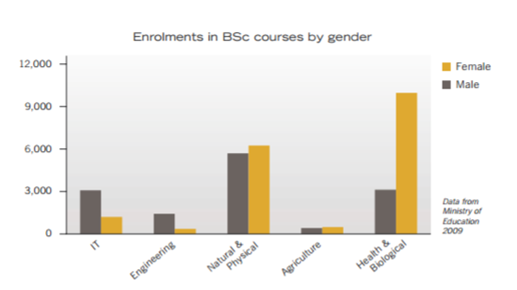
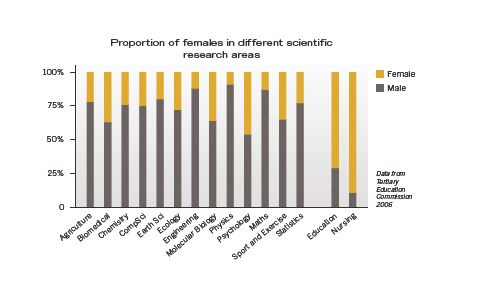
(Source: http://www.awis.org.nz/wis-in-nz/statistics/ )
This pattern repeats itself in the wider workforce, with women underrepresented in STEM-dependant workplaces.

According to the last census, of almost 40,000 computing professionals, only 25% are women; of 6,132 IT Managers, only 22% are women; and of 6,291 computer equipment controllers, only 25% are women. The disparity then continues across average income for BSc graduates. And to top it off, Kiwi women are earning $4.09 less than men on the average hourly wage, according to newly-released income figures from Statistics New Zealand.
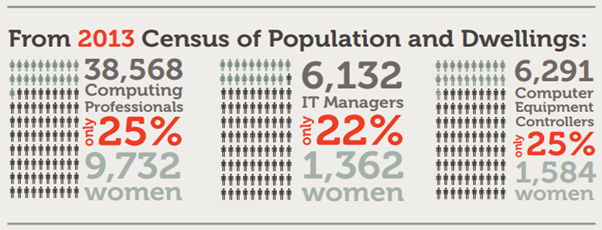
Why aren’t more women going into IT and technology based professions?
While women are going into STEM careers in record numbers, there’s still work that needs to be done to keep them there. As you can probably expect, the answer is… it’s complicated.
The IT industry is subject to the same ebbs and flows of other industries (people stopping work to have families, injuries, illnesses, retirement) but it does appear to have a few unique problems.
The Australian Business Insider recently asked a bunch of founders to pinpoint the “main driver between women and ethnic minorities being underrepresented in tech” and the results were:
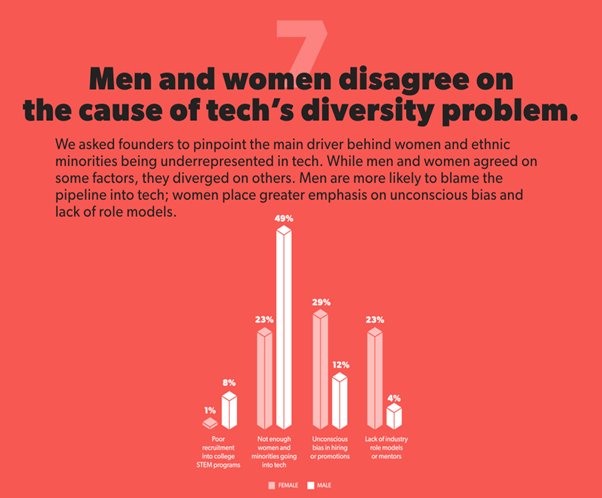
Nearly half of all men surveyed pointed to the age old excuse: there simply aren’t as many women or members of certain minorities qualified to do the jobs tech companies need done. When women were posed the same question, their response was totally different: women in tech largely attributed the industry’s diversity problem to unconscious bias in hiring or promotions followed by a lack of female role models in the industry.
IT, innovation and business – why workplace culture must matter
While more women are going into STEM careers, the real struggle is keeping them there. NZ Professor Margaret Brimble, Rutherford Medal recipient and all round science champion, says for many women in STEM it’s difficult to stay in the career after the PhD and post-doctoral work, because they’re hitting their 30s and that’s the time many people consider having children; “And so it’s that absolutely critical part when you’d normally embark on your independent career, suddenly the women have to fit in this family thing as well. And that’s really quite challenging. A lot of the positions you get as a young scientist are only short-term, short-contract type work. So it’s hard to keep going.”
Brimble’s thoughts are backed up by research out of the University of Texas at Austin, which found that women are leaving STEM careers at more than twice the rate of women in other jobs. And wanting to raise a family certainly isn’t the only factor, especially when you consider things such as pay equality and New Zealand’s gender pay gap.
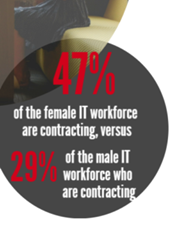
In our latest Absolute IT Wellington Report (PDF) we found that women working in IT in New Zealand are also far more prone to contract than men. In Wellington 47% of women working in IT contract and only 29% of the male workforce do; in Auckland 32% of women contract versus 21% of men; in Hamilton 31% of women are contracting versus 15% of men and in Christchurch 29% of women contract versus 20% of men.
The reasons why women prefer to contract in IT are mostly the flexibility that contracting offers, better income rates and the chance for women who are returning to the workforce to quickly get their skills up to date and grow their professional network.
So, what is being done to address the gender imbalance in tech?
Some research shows the gender pay gap is rapidly closing in NZ, and attitudes are changing too. But even more promisingly, new initiatives from the Government, business, and education sectors, are being carried out to maximise women’s involvement and contribution in the science and technology industries.
Starting with schools and education.
Bringing technology into primary school classrooms is just one way to build confidence in girls to work with and around technology. The Ministry for Women has created a web directory for STEM initiatives throughout NZ, that focus on bringing young women into these areas of schooling and education.
The Mind Lab by Unitec aims to enhance digital literacy capability and the implement contemporary practice in the teaching profession. They offer a range of services, from school holiday activities for children aged 7 to 12 years to post-graduate scholarships for public school teachers, to upskill them on tech and teaching tech in the classroom.

The good news is
The good news is, there’s strong labour market demand for more skilled technology professionals, and many employers recognise the need to increase the number of women who graduate with IT qualifications to help meet that demand. Savvy IT employers are offering flexible working conditions, job sharing or part-time contracting employment options to attract more women to their work force.
A report by the Ministry of Women highlights the fact that “due to the shortage of graduates there is an increased opportunity to NZ women to gain good employment in the sector”.
The opportunities for women in IT are endless and as whole, we in this industry need to work harder to attract more women into the world of IT and communicate the many benefits of working in such an innovative, exciting and worthwhile industry.
We have a variety of opportunities for women in IT and we are passionate to help the industry diversify. If you’re interested in getting started in a career in IT and want to know more about what a future career in IT can look like, get in touch with us today, we will support you throughout the entire process.
Further reading
- Idealog: NZ Innovation, no women allowed?
- http://www2.deloitte.com/global/en/pages/technology-media-and-telecommunications/articles/tmt-pred16-tech-women-in-it-jobs.html
- http://www.nzherald.co.nz/business/news/article.cfm?c_id=3&objectid=11340549
- https://www.theguardian.com/lifeandstyle/2012/oct/01/so-few-women-working-technology














